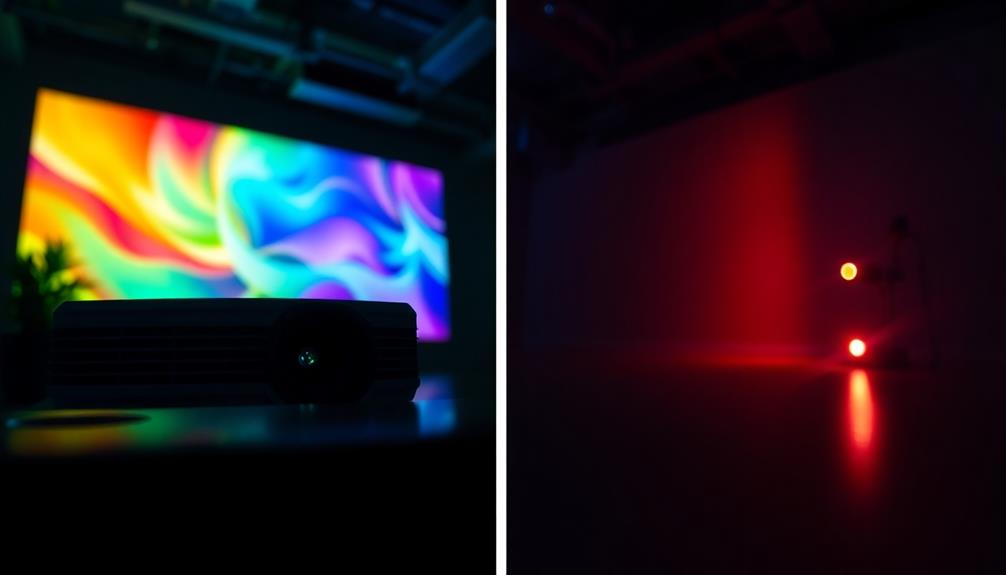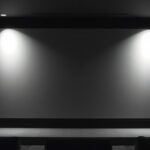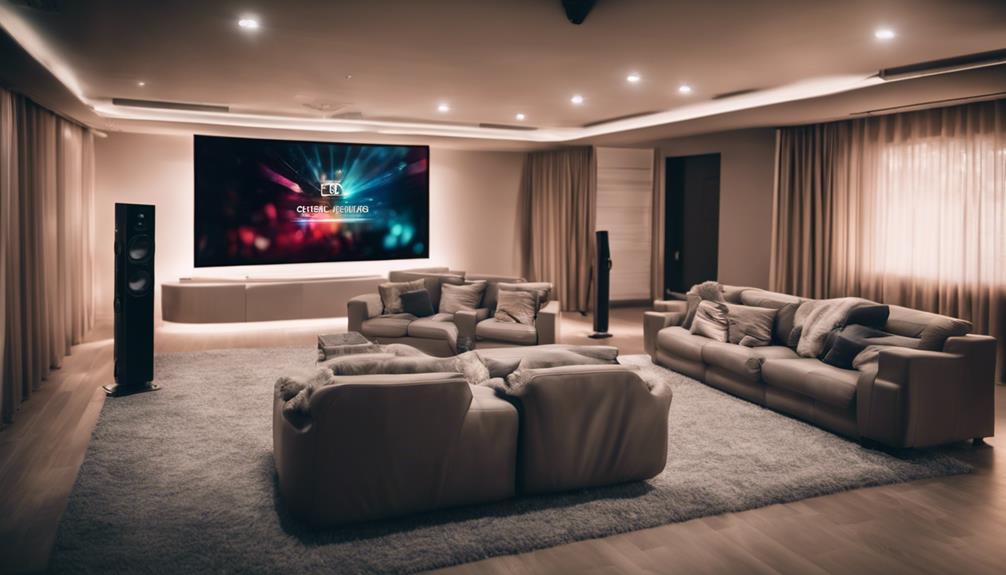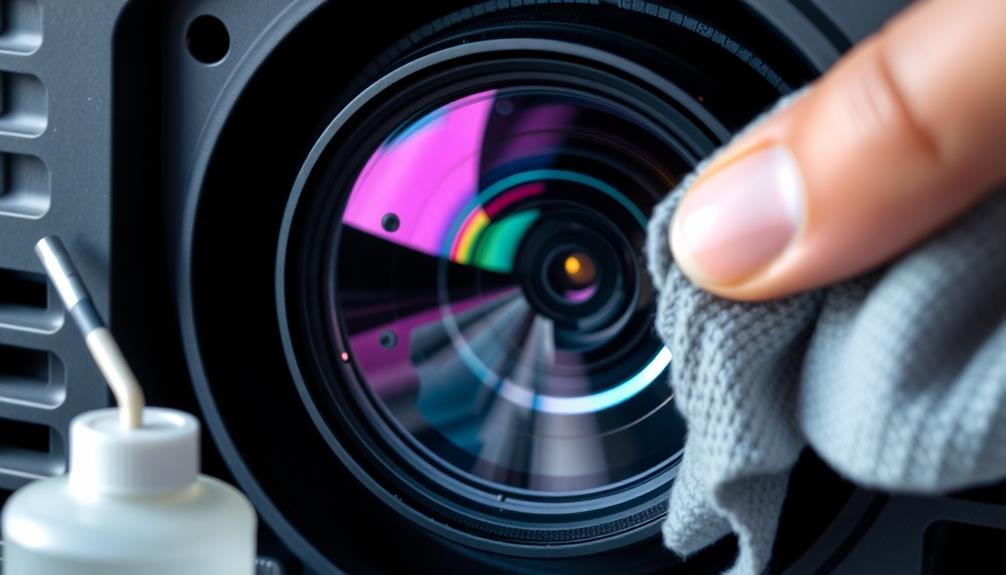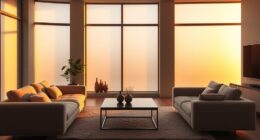Projector contrast ratio measures the difference in brightness between the brightest whites and the darkest blacks. A higher contrast ratio means better image quality, allowing you to see more detail, especially in dark scenes. For home theaters, you should look for a minimum of 2000:1 for ideal viewing. Knowing the difference between native and dynamic contrast ratios is essential, as inflated specs can mislead your purchase. Better contrast enhances color depth and overall viewing satisfaction. If you want to understand how to choose the right projector and make informed decisions, there's plenty more to uncover.
Key Takeaways
- The contrast ratio measures the difference between the brightest whites and darkest blacks, affecting overall image quality and detail visibility.
- A higher native contrast ratio (ideally above 2000:1) enhances viewing experiences, especially in low-light environments like home theaters.
- ANSI contrast ratings provide a more realistic assessment of projector performance compared to inflated full on/off specs often used in marketing.
- Factors such as ambient light and screen type significantly influence perceived contrast, making higher ratios essential in brighter settings.
- Understanding contrast specifications helps consumers make informed decisions, ensuring they choose projectors that deliver vibrant and clear images.
Understanding Contrast Ratio
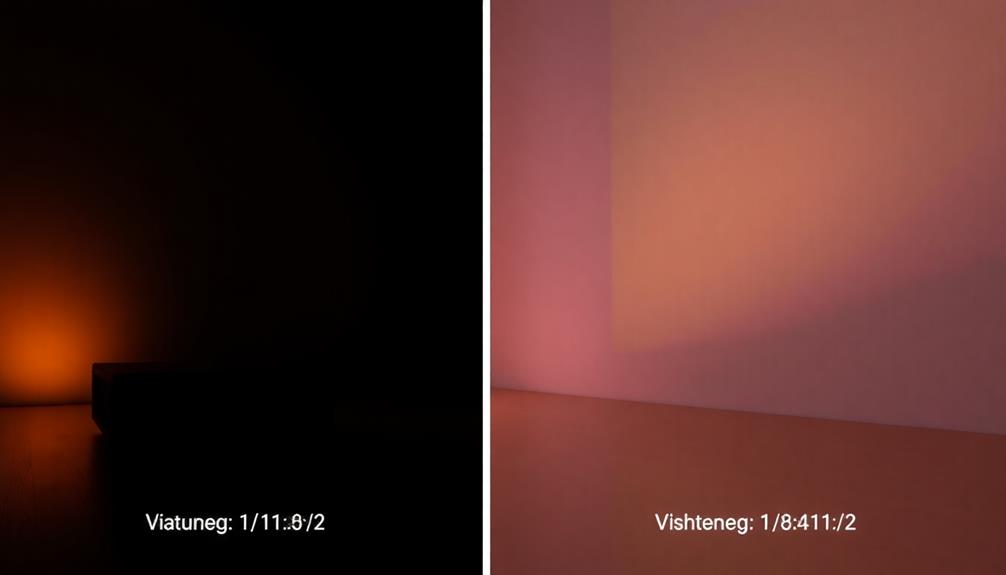
Understanding contrast ratio is vital for anyone looking to optimize their viewing experience with a projector. The contrast ratio measures the brightness difference between the brightest whites and the darkest blacks in an image. A higher contrast ratio means better image quality and more detail visibility, helping you appreciate textures and subtleties in your content. For example, a 1000:1 contrast ratio indicates that the brightest white is 1000 times brighter than the darkest black.
When evaluating projectors, consider the native contrast ratio, which reflects the inherent brightness range without any dynamic adjustments. This gives you a true benchmark of performance.
On the other hand, dynamic contrast ratios involve adjustments made by the projector to enhance brightness during various scenes, which can sometimes mislead your perception of quality.
High contrast ratios are particularly important in low-light environments, allowing you to enjoy deeper black levels and vibrant colors. This guarantees that your viewing experience is immersive and engaging, whether you're watching movies or playing games.
Importance of Contrast Ratio
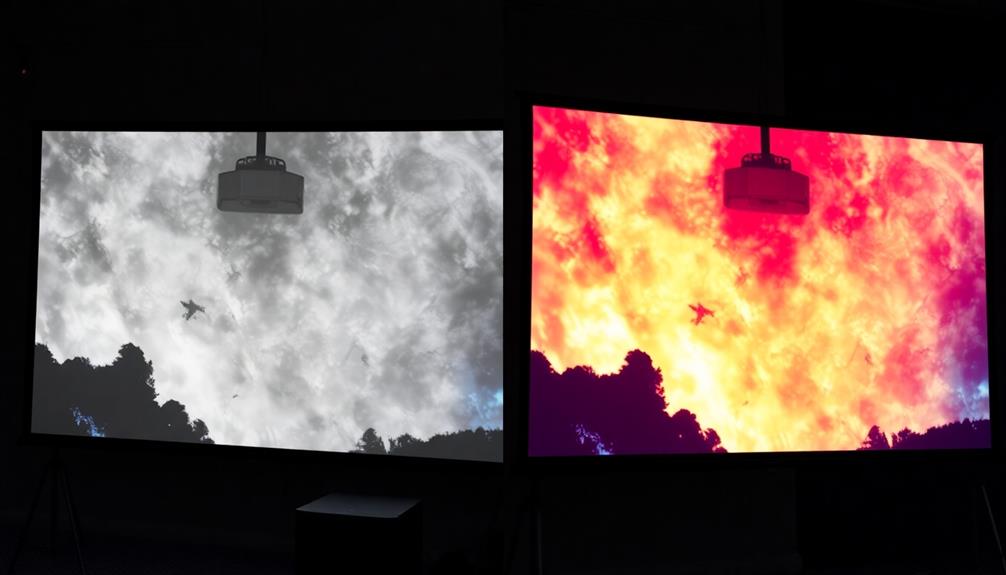
When it comes to enjoying high-quality visuals, the significance of contrast ratio can't be overstated. A high contrast ratio is essential for enhancing image quality, especially in dark scenes. It makes those scenes appear more dynamic and engaging, allowing you to appreciate the finer details that would otherwise be lost in shadows.
For home theater projectors, aiming for a minimum contrast ratio of 2000:1 is recommended to achieve the best viewing experience in low-light environments.
While brightness might be prioritized in business settings, a contrast ratio between 200-1000:1 still plays a critical role in delivering clear text and presentations. High contrast ratios also improve the perceived contrast of colors, enriching the depth and richness of the visuals. This allows for better distinction between subtle shades and textures, making your viewing experience far more immersive.
Moreover, focusing on native contrast ratios, which reflect a projector's true performance without dynamic adjustments, is essential. These are more reliable indicators of quality than inflated dynamic contrast ratings.
Measuring Contrast Ratios

Measuring contrast ratios accurately is essential for evaluating a projector's true performance. There are two primary methods for measuring contrast: Full On/Off Contrast and ANSI Contrast.
Full On/Off Contrast compares the brightness of solid black and white screens, often yielding misleadingly high ratings that can reach into the millions, especially for dynamic contrast. Meanwhile, ANSI Contrast uses a checkerboard pattern of alternating black and white squares, providing a more realistic assessment of a projector's performance in typical viewing conditions.
You should note that ANSI Contrast ratings generally range from 200:1 to 600:1, with an average of around 300:1 for home theater projectors. Values of 700:1 are considered very good, emphasizing the significance of understanding these metrics.
To achieve accurate measurements, it's crucial to control external light interference during testing. This guarantees that the results reflect the true capabilities of the projector.
Unfortunately, manufacturers often don't publish ANSI Contrast specs, so it's essential to rely on independent reviews and tests to get a realistic understanding of a projector's performance.
Different Contrast Measurement Methods
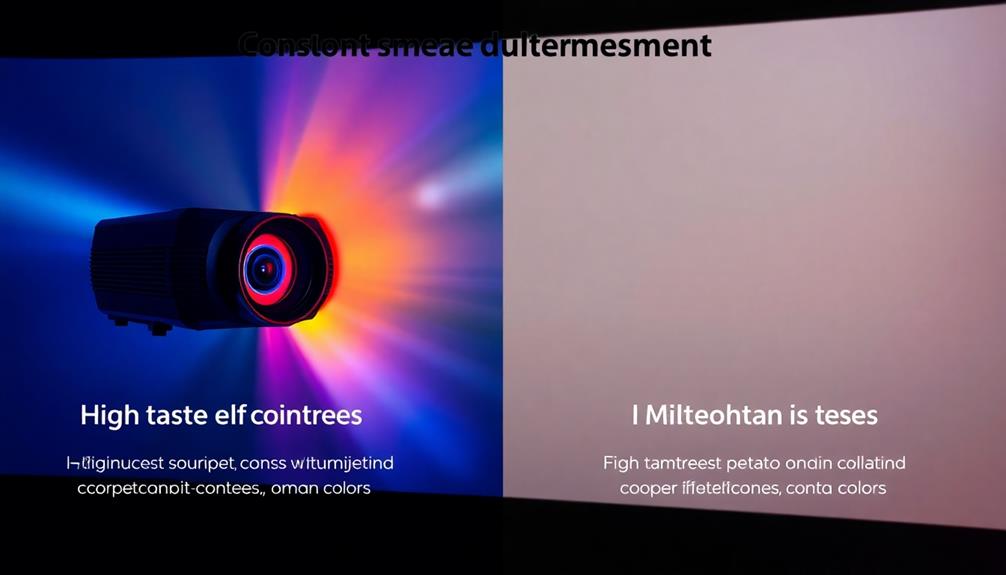
Two main contrast measurement methods play an important role in evaluating projector performance: Full On/Off Contrast and ANSI Contrast.
Full On/Off contrast measures the brightness of solid white versus solid black, often leading to inflated marketing numbers that can be misleading. For instance, a projector might boast a Full On/Off rating of 1200:1, but its actual picture quality could be considerably lower when you consider ANSI contrast.
ANSI contrast, on the other hand, uses a checkerboard pattern of alternating black and white squares. This method provides a more realistic representation of viewing conditions, typically yielding an average ANSI contrast rating of around 300:1 for home theater projectors. A rating of 700:1 is considered very good.
Understanding these contrast measurement methods is vital because many manufacturers don't disclose ANSI specs, resulting in consumer confusion.
As you evaluate projectors, keep in mind that while Full On/Off ratings can appear impressive, they may not reflect true performance. By focusing on ANSI contrast, you'll gain a clearer understanding of how a projector will perform in real-world situations.
Factors Affecting Image Quality
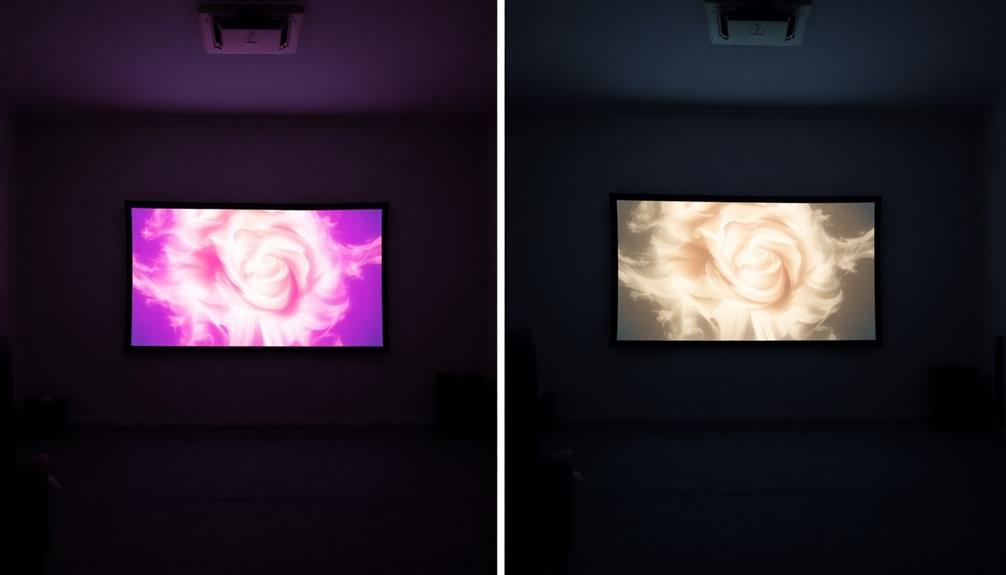
When you're setting up your projector, keep in mind how ambient light can impact the image quality.
It can wash out your colors and reduce contrast, even if the projector's native ratios remain unaffected.
Understanding measurement techniques will also help you evaluate how these factors play into the overall viewing experience.
Ambient Light Influence
Ambient light often plays an essential role in determining the effectiveness of your projector, as it can dramatically impact image quality. When you're in a well-lit room, higher levels of ambient light can wash out images, reducing perceived contrast and clarity.
This is where projectors with higher native contrast ratios, ideally above 2000:1, shine. They're better equipped to handle ambient light, maintaining detail and brightness even in challenging conditions.
However, you should be aware that ANSI contrast measurements, which reflect real-world viewing scenarios, can drop considerably in bright settings. In such cases, your projector might fall below the ideal ranges, compromising your viewing experience.
To combat these effects, invest in a projector with good brightness ratings and higher contrast ratios; this combination can help you achieve clearer images despite the surrounding light.
Additionally, consider using dark or specialized projector screens. These can enhance perceived contrast in ambient light settings, allowing for better visual performance without sacrificing brightness.
Measurement Techniques Impact
Understanding a projector's measurement techniques is essential for evaluating its contrast ratio accurately. The disparity between Full On/Off contrast and ANSI contrast can profoundly affect your viewing experience.
Full On/Off contrast might impress with inflated numbers, but it often misrepresents real-world conditions. In contrast, ANSI contrast uses a checkerboard pattern to deliver a more realistic evaluation, which typically results in lower yet more reliable values.
Consider these emotional factors when examining your projector's performance:
- A vibrant movie night can be ruined by poor black levels.
- You deserve to see every detail, not just bright spots.
- Ambience matters; don't let light wash out your visuals.
- Your projector settings should enhance, not hinder, your experience.
Ambient light plays a critical role, diminishing perceived ANSI contrast. To improve black levels, minimize internal reflections and optimize your projector settings.
Misleading Contrast Specifications
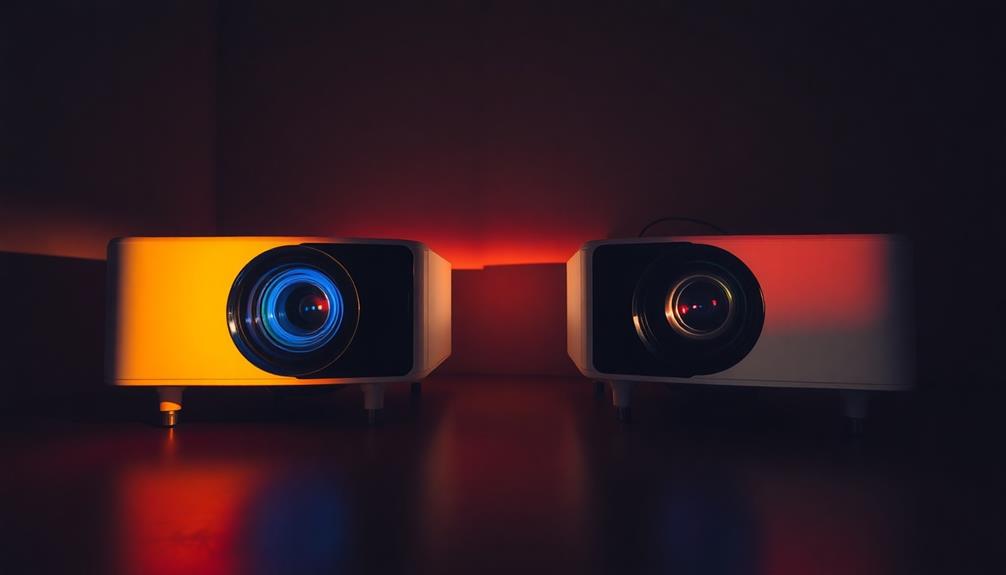
Projector specifications can often be confusing, especially when it comes to contrast ratios. Many manufacturers inflate these specs, particularly in dynamic and full on/off ratings, which can mislead you about a projector's actual performance. For instance, a projector may boast a full on/off contrast ratio of 1200:1, but its ANSI contrast rating could be only 250:1. This highlights the disparity between claims and real-world performance.
Understanding the differences among these contrast specifications is vital for making an informed decision. Here's a quick comparison of common terms:
| Contrast Type | Description | Example Ratio |
|---|---|---|
| Full On/Off | Maximum contrast under ideal conditions | 1200:1 |
| ANSI Contrast | More realistic assessment in typical viewing scenarios | 250:1 |
| Native Contrast | True capability without adjustable features | 500:1 |
High dynamic contrast ratings might create a misleading perception, as they don't always reflect consistent performance during actual use. Focus on native and ANSI contrast for a clearer understanding of your projector's video image quality.
Recommended Contrast Ratios by Use Case
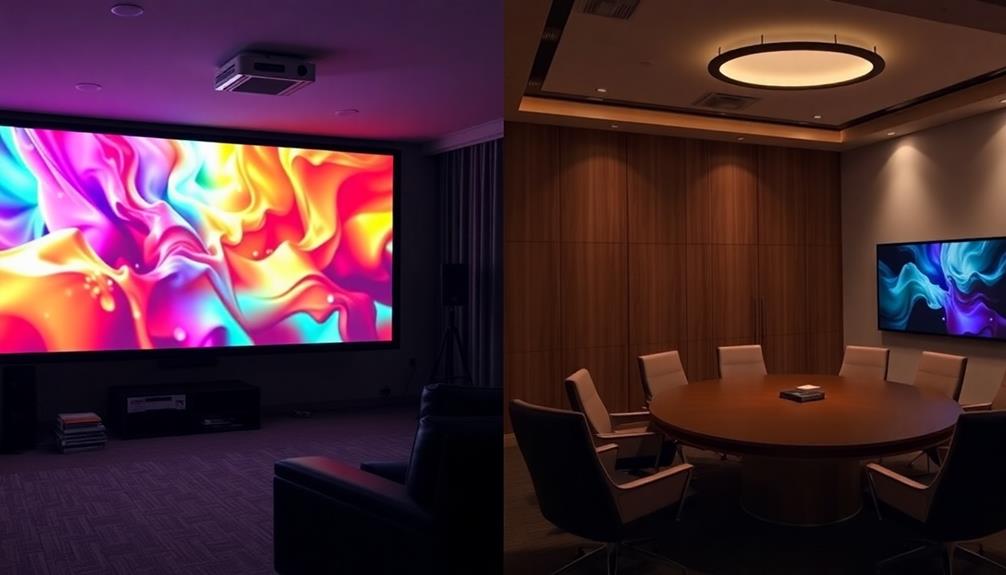
Choosing the right contrast ratio for your projector can greatly enhance your viewing experience, depending on how you plan to use it.
Here's a quick guide to help you select the ideal contrast ratio for various scenarios:
- Home theaters: Aim for at least a 2000:1 contrast ratio for the best quality of the image in low-light environments.
- Ultra short throw projectors: Look for a sequential contrast ratio over 1000:1, with 4K models ideally ranging from 1000:1 to 2500:1 for enhanced image quality.
- Gaming projectors: A minimum contrast ratio of 2000:1 is best for immersive gameplay, while 1000:1 is acceptable for less demanding setups.
- Business and church projectors: Target a contrast ratio between 200-1000:1, focusing on brightness to guarantee clarity in well-lit environments.
Choosing the right contrast ratio not only impacts how you perceive light and dark but also elevates your overall experience.
Perceived vs. Actual Contrast Ratios
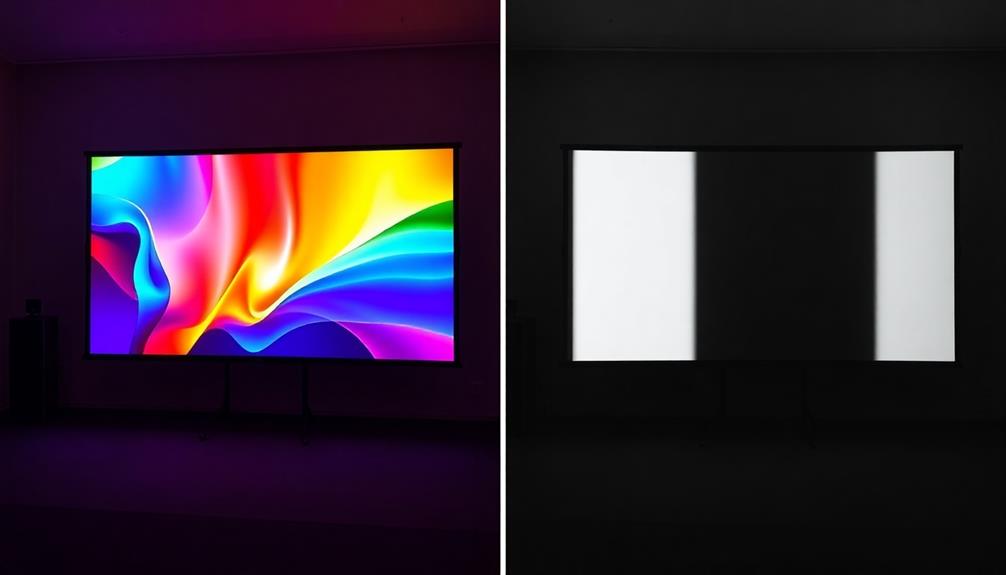
When it comes to viewing experiences, the difference between perceived and actual contrast ratios can be striking. While you might see impressive numbers in manufacturers' specifications, those figures often reflect dynamic contrast, which can be misleading.
For instance, a projector might boast a dynamic contrast ratio of 1,000,000:1, but its actual measurements could reveal a native contrast of only 2,000:1.
Actual contrast ratios are determined through standardized methods like ANSI contrast, which give you a more accurate portrayal of performance. Most home theater projectors fall within a realistic range of 200:1 to 600:1.
Your perception of contrast can also be greatly influenced by factors like ambient light and viewing distance. In darker environments, a projector with high native contrast can deliver noticeably better image quality than a low dynamic ratio model.
Understanding the distinction between perceived contrast and true contrast capabilities is essential. If you rely solely on inflated performance claims, you may end up disappointed with your purchase.
Always consider actual measurements to guarantee you're making an informed decision for your viewing needs.
Enhancing Viewing Experience
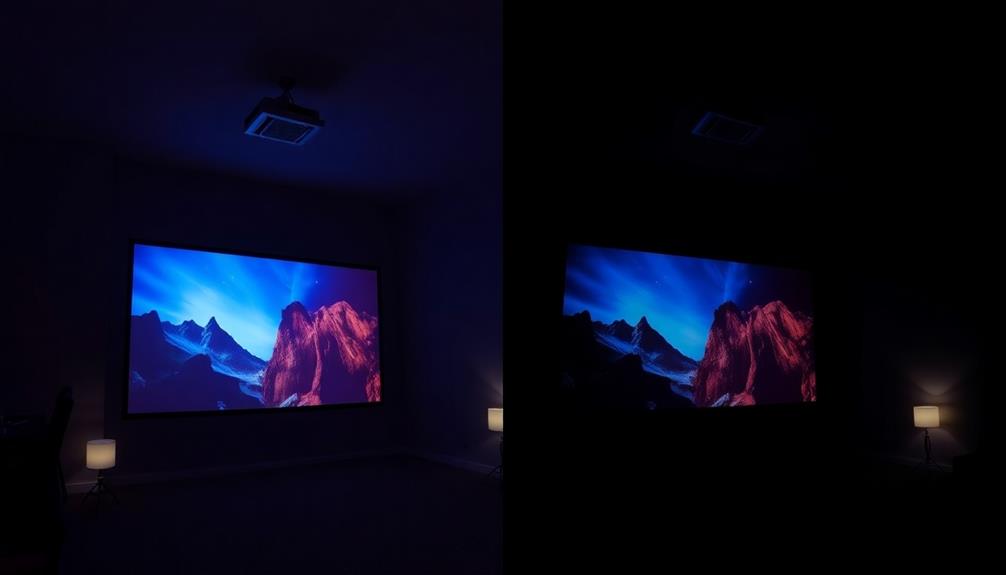
To truly enhance your viewing experience, focus on the visual clarity and color depth your projector can provide.
A high contrast ratio lets you see finer details and richer colors, making every scene pop.
Whether you're watching movies or gaming, investing in a projector with excellent contrast can transform your setup into an immersive escape.
Visual Clarity Improvement
A contrast ratio of 2000:1 or higher can dramatically enhance your viewing experience by ensuring sharp images and vibrant colors. The difference between black levels and brighter than black areas becomes strikingly clear, resulting in a more immersive projected image.
This level of visual clarity allows you to appreciate the finer details, particularly in low-light environments where shadows can often obscure important elements.
With elevated contrast ratios, you can expect:
- Rich, dynamic visuals that draw you into the content.
- Enhanced detail in both light and dark areas, revealing hidden textures.
- An immersive experience that feels almost three-dimensional.
- Greater emotional engagement with the story being told on screen.
ANSI contrast measurements provide a more accurate assessment of your projector's capabilities, ensuring you enjoy impressive image quality.
Low contrast ratios often lead to flat, washed-out images, while high ratios create a vibrant viewing experience that captivates your attention.
Color Depth Enhancement
High color depth plays a significant role in enhancing your viewing experience, complementing the benefits of improved contrast ratios. When you choose a projector with a high contrast ratio, you're not just improving the brightness of a solid; you're also enabling deep blacks and richer colors. This combination allows for better detail in complex scenes, especially in dark environments.
Color depth refers to the number of bits used for each pixel, with higher color depth (like 10-bit) allowing for over a billion colors. This level of detail enhances your perception of subtle color variations, essential for cinematic visuals in home theaters. Many modern projectors support HDR (High Dynamic Range) content, requiring at least 10-bit color depth to fully utilize the expanded Dynamic Range.
Here's a quick comparison of color depth and its impact:
| Color Depth | Full On/Off Contrast Ratio | Visual Experience |
|---|---|---|
| 8-bit | Standard | Limited gradients |
| 10-bit | High | Smooth shifts |
| 12-bit | Very High | Exceptional detail |
| HDR | Enhanced | Vibrant imagery |
| Deep Blacks | Improved | Richer visuals |
Investing in a projector with high color depth and contrast ratio transforms your viewing experience.
Making Informed Purchasing Decisions
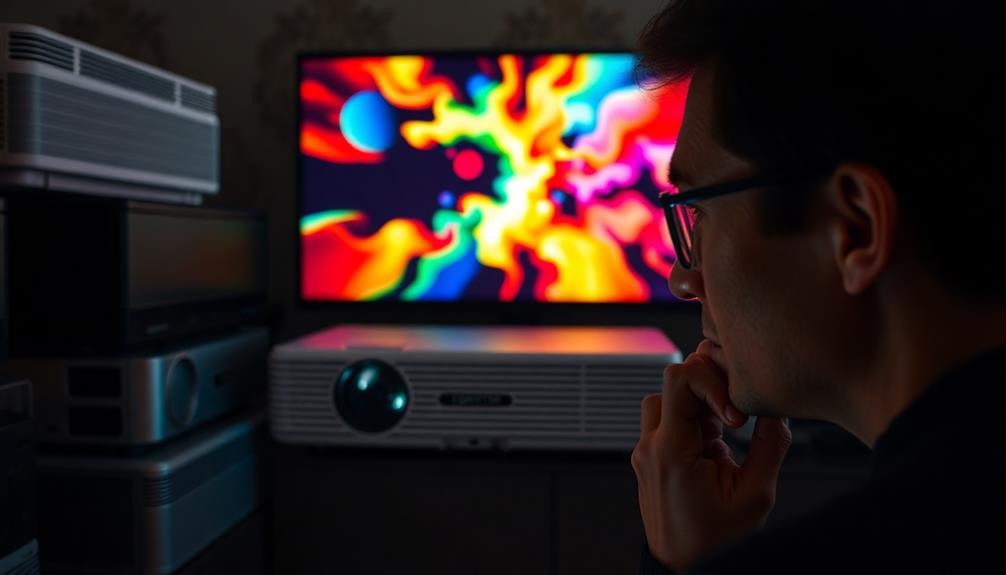
When you're shopping for a projector, it's important to focus on the native contrast ratio rather than getting distracted by dynamic contrast numbers. The native contrast ratio provides a more accurate representation of real-world performance and image quality, especially vital for home theater projectors.
Aim for a native contrast ratio of at least 2000:1 to guarantee vibrant images and clear details, even in low-light conditions.
Be wary of inflated contrast ratios from manufacturers, as they often use misleading Full On/Off measurements. Instead, look at ANSI contrast measurements, which offer a more realistic understanding of how a projector will perform with actual content.
Researching independent reviews can further clarify a projector's true contrast performance, significant for making an informed purchasing decision.
- Experience stunning visuals that immerse you in every scene
- Enjoy crisp details that pop, even in dark environments
- Avoid disappointment by choosing a projector that meets your expectations
- Transform your home theater into a cinematic paradise
Frequently Asked Questions
What Is a Good Contrast Ratio for a Projector?
A good contrast ratio for your projector typically starts at 2000:1 for home theaters. For gaming, aim for at least 2000:1, while business projectors can function well with ratios between 200-1000:1 in bright settings.
Is 3000:1 Contrast Better Than 1000:1?
A 3000:1 contrast ratio isn't just better; it's like comparing a dazzling diamond to a dull pebble. You'll experience richer colors, deeper blacks, and stunning details, transforming your viewing into an unforgettable spectacle!
Is 5000:1 Contrast Ratio Good?
A 5000:1 contrast ratio is definitely good for enhancing your viewing experience. It delivers strong color saturation and depth, making details in bright and dark scenes pop, especially in low-light environments. Enjoy your cinematic moments!
Is 1500:1 a Good Contrast Ratio?
Think of contrast ratio as the canvas for your visuals. A 1500:1 ratio isn't bad for general use, but if you're craving vibrant details in darker scenes, you might want something higher for that cinematic touch.
Conclusion
In the world of projectors, understanding contrast ratio isn't just a technical detail—it's a gateway to superior image quality, vibrant colors, and an immersive viewing experience. Whether you're watching movies, playing games, or delivering presentations, knowing the right contrast ratio can make all the difference. So, enhance your enjoyment, elevate your presentations, and enrich your movie nights by choosing a projector that meets your contrast needs. Make informed decisions, and let your visuals shine!
